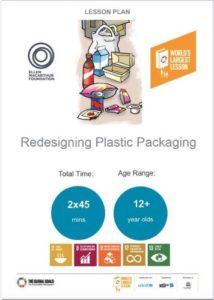In 2015, 193 countries committed to achieving the 17 Sustainable Development Goals (SDGs) of the United Nations. The extent to which that vision becomes a reality will in no small way depend on what is happening in today’s classrooms. Indeed, it is educators who hold the key to ensuring that the SDGs become a real social contract with citizens.
Today my discussion is about plastics. The topic is enormous as is the issue for our planet. It’s too big for any one country to tackle and requires a global partnership.
Students could pose questions from a viewing of this video and discuss actions they and their families could take. Could they create a community awareness program for their school?
Finally, here’s is a lesson from the World’s Largest Lesson on redesigning plastic packaging.
For secondary students, this could be adjusted for younger learners and provides open ended, project based opportunities to enhance global competences towards global citizenship.

Marilyn Snider can be contacted at marilyn@bethinkglobal.com.au
Find out more at Bethink Global
